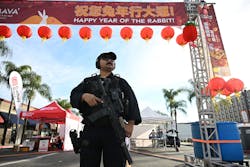Spate of mass shootings shows continued challenges with ‘soft targets’
Mass shootings in schools, campuses and high-profile public buildings often garner much of the news coverage and discussion among industry stakeholders.
But the wave of shootings that gripped the western U.S. recently served as a reminder to the security industry that many other “soft targets” remain vulnerable to attack.
In its landmark study of mass shootings released last year, the National Institute of Justice noted 31% of mass shootings over the last 50 years occurred in the workplace, 17% in retail establishments and 13% in a bar or restaurant. Churches, outdoor venues and K-12 and college campuses were further down the list.
The U.S. Secret Service National Threat Assessment Center, which released a report about “mass attacks” in public spaces this month, found 51% occurred in businesses, followed by open spaces at 35%. The rest included schools and universities, shared communal areas and places of worship.
For optical, practical, logistical or cost-related reasons, some of these types of venues haven’t embraced more robust security systems, or any systems at all.
Public safety officials also face new challenges with intelligence gathering. Two of the alleged shooters in California did not fit the typical profile of a mass shooter. The NIJ study found the mean age of mass shooters was 34, and 81% were of shooters were white, black or Latino. Two of the suspects in the California incidents were older Chinese males.
Here’s what is known publicly about the three shooting suspects in the western U.S.:
* Huu Can Tran, 72, walked in the front door of the Star Ballroom Dance Studio in Monterey Park, Calif., and used a variant of a MAC-10 semi-automatic machine pistol to kill 11 people and injured numerous others. He later invaded the Lai Lai Ballroom & Studio in nearby Alhambra but was disarmed by a patron and Tran fled. There was early speculation about the motive being a personal dispute or grievance, but authorities said recently Tran had no known relationship to the victims. The motive for the massacre remains unclear.
* 66-year-old Chunli Zhao killed 7 people at two mushroom farms in California, using a gun he legally owned. During a jailhouse interview with NBC Bay Area, Zhao admitted to the killings. Zhao alleged he’d been bulled and subjected to long work hours for years, and that he might have some kind of mental illness. He said he wasn’t in his right mind during the killings.
Authorities said they knew of no “preceding factors” that would have suggested Zhao would carry out the attack. But CNN reported Zhao was subject to a temporary restraining order after a former coworker and roommate accused him of attacking and threatening him in 2013.
A judge issued a temporary restraining order against Zhao, which prevented him from getting too close to the employee and banned him from owning or buying a gun. The restraining order expired in July 2013.
* Jarid Haddock, 21, was found deceased with a self-inflicted gunshot wound several hours after walking into a Circle K convenience store in Yakima, Wash. and started firing on patrons. Haddock’s mother told police that her son had been a methamphetamine user for three years and that his drug use had gotten worse in the past month, an affidavit said. She said her son, who had been acting “crazy,” had a handgun as well as access to two long guns, including an AK-47-style rifle.
Deadly Denial
There are two primary issues preventing establishments from implementing more effective strategies to prevent mass shootings: denial, and underestimating the potential offender, says Jin Kim, a widely regarded subject matter expert and material practitioner in active shooter and workplace violence risk management and advisory board member for Shooter Detection Systems.
“The current risk we have will be different than one 10 years from now because the suspects are learning from each other,” says Kim, who retired from the FBI after a 23-year career in the New York office. “They’re becoming far more tactically sophisticated and more efficient in their application of deadly force.
“You can’t underestimate how easy it is to make forced entry into a structure that might not have been designed to withstand a firearm assault or violent encounter.”
Chris Grollnek, a longtime active shooter expert who founded the Active Shooter Prevention Project, believes the public needs to reimagine its understanding of an active shooter incident.
Mass shooting incidents often take place for 0-8 minutes and law enforcement may not even arrive until eight minutes after the initial call, and there may be no contact with the first victim for up to 23 minutes. “So that means I’ve got to be prepared to be by myself for eight minutes,” Grollnek says.
In the Monterey Park, Calif. incident, Tran attempted something similar at a second dance hall, but a patron wrestled the gun away. While praising the man for taking action, Grollnek adds, “Are we going to rely on there being a good citizen at every location to wrestle away a firearm?”
Grollnek believes many “soft targets” need more aggressive security programs to protect against mass shootings. They need to go through a process called “the painful onion” that involves not just a single-source solution but comprehensive safety assessments, technology tailored to a structure’s unique challenges and better employee training, he says.Training for employees must go beyond typical approaches like watching a video, Grollnek says, as employees must know the appropriate places to run or hide if an incident does occur.
Patrick Fiel Sr., who has over 40 years of experience managing security and law enforcement organizations, said it’s critical for all businesses to review their emergency/crisis plans, lockdown procedures and employee training.
Businesses need to hold safety/security drills with emergency responders, and practice responses to different emergency situations, such as an active shooter, he says.
Through careful planning, it is possible for businesses to develop a quality emergency crisis plan that thorough risk assessment, including an all-hazards approach of all their buildings and properties, Fiel says. A risk assessment pinpoints critical areas of vulnerability and will identify the security strengths, as well as any security weaknesses.
“Any plan will undoubtedly include security technology, but no single security implementation will protect a business. True protection comes from many layers of security protocols and processes,” Fiel says.
Kim says security professionals often face a difficult time implementing such plans due to the complexity of issues causing mass shootings and the reluctance of some C-suite executives to address security measures in their own facilities.
“They just don’t have the appetite, or the understanding or the knowledge of what the risk is and how it can affect them so easily on any single day. So, when we look at retail, those public and semi-public, public access places, they’re clearly examples of people who never thought they could be impacted by it,” Kim says.
“I think we need a new outlook, a more progressive outlook, that requires more human intervention and processes to provide help before someone crosses over into violence,” he adds.
“I have always stated that prevention costs less than reaction,” Fiel says. “A serious incident of violence is actually 100 times more expensive than taking pro-active measures to prevent the incident from occurring.”
Technology is There
Grollnek wants to see more businesses improve their security posture by employing facial recognition and analytics tools in cameras to not only warn employees and patrons of a potential mass shooter event but speed up alerts to law enforcement.
Omnilert, a Washington, DC-based organization that employs automation and next-generation artificial intelligence to expedite emergency response and enable detection and visualization of critical incidents, uses existing security cameras, AI-powered monitoring software and human verification to detect gunshots and notify law enforcement.
There are other security solutions that could help augment security, Grollnek says. One is Wingshield, a customized mobile shelter-in-place device that could be used when active-shooter protocols are enacted.
Grollnek also mentioned SWARM from Tampa, Fla.-based Galileo Group, which uses sensors in the phones to create virtual positional and operational mosaics, with leaders analyzing the data derived from spatial and time-lapse measurements.
SWARM integrates the data from the sensors to generate a geo-spatially referenced set of user metrics. Video streams gathered by SWARM users add an additional layer to a centralized view, or tablet, encompassing what would be hundreds of discrete smartphone data collectors.
The total information is then processed in real time using artificial intelligence and other analytical techniques to provide summary information to community leaders working to react to the situation appropriately.
“The Secret Service says it takes a minute for a civilian inside an active shooter situation to call the police. That’s true. But it takes four minutes for a civilian to realize they're in an active shooter before they realize they need to call police. So the real time is five minutes,” Grollnek says. “If you erase the first five minutes, you can get police on scene in three minutes because the average time is eight minutes to get on scene.
“Now, you’ve got police responding at three minutes, and you give them a five-minute fighting chance to lower the victim count.”





